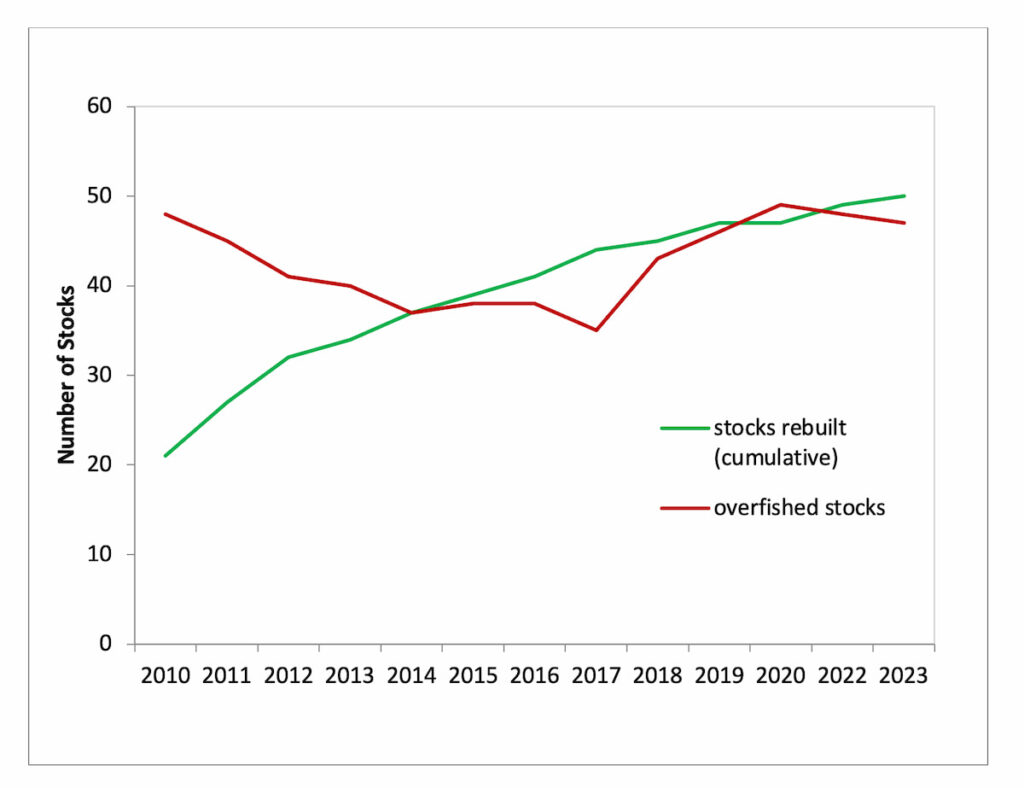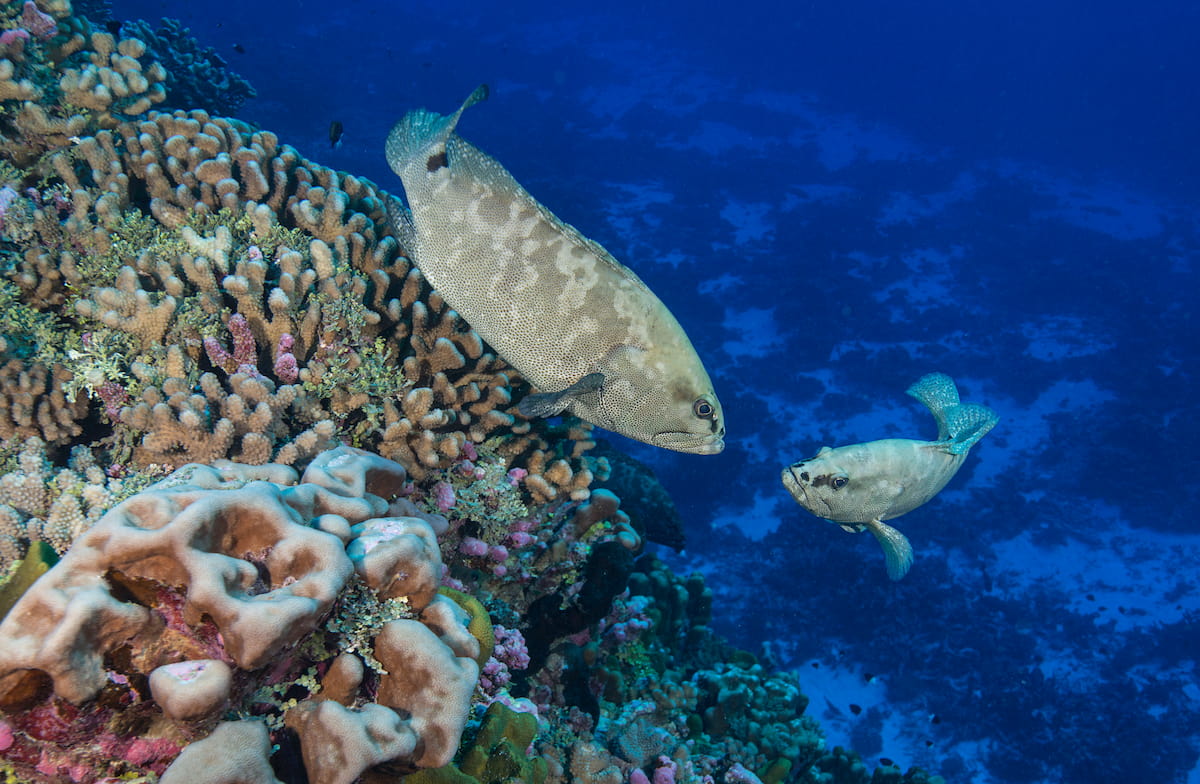The 2023 Status of Stocks report illustrates the challenges of managing U.S. fisheries sustainably in an era where climate change is not down the road—it has already arrived. Overfishing remains a persistent issue, and rebuilding efforts continue to fall short of needed progress. To make rebuilding plans effective and restore healthy conditions, NOAA Fisheries must prioritize ecosystem considerations. Adapting management approaches to incorporate the changing climate and shifting ocean conditions is essential for the long-term health of our fisheries. Fishery managers, scientists and the fishing industry must work collaboratively to develop adaptive, ecosystem-based strategies that promote resilience and ensure fishing practices remain sustainable in the face of climate change.
Never miss an update
Enter your email and never miss an update
again or contact 1.888.780.6763
var form = document.getElementById(’email-signup-664e64837b12d’);
form.querySelector(‘.rsform__field–email’).addEventListener(“nb:result”, e => {
var nbStatus = form.querySelector(“[name=”nb_email_status”]”);
var nbDate = form.querySelector(“[name=”nb_validation_date”]”);
var currentDate = new Date();
nbStatus.value = e.detail.result.response.result;
nbDate.value = currentDate.toISOString().split(‘T’)[0];
grecaptcha.enterprise.ready(async () => {
var tokenField = document.querySelector(“#email-signup-664e64837b12d [name=”token”]”);
var token = await grecaptcha.enterprise.execute(‘6Lcmr3shAAAAAAVRlvJrsUufEEQuItzNDlkpmB2g’, {action: ‘verify’});
tokenField.value = token;
});
});
<!– –>
For many years, the United States has taken pride in its world-class fishery management infrastructure which seeks to maintain sustainable fishing and abundant fish populations that can provide us with food and support businesses, recreation and culture. But a recent report from the agency that manages our marine fisheries reveals that while some progress has been made in the past year, many fish stocks around the country are at concerningly low levels of abundance. Even more alarming is that the steps we are taking to try to rebuild those fish stocks are rarely having an impact. Particularly as climate change disrupts our ocean and puts our fishing communities at risk, fishery managers need to act decisively to reverse these trends.
Too Many Stocks are Still Overfished
NOAA’s Status of Stocks report, which is delivered every year to Congress, serves as a vital health check for U.S. fisheries. The 2023 report focuses on a few key metrics: the fish stocks currently subject to overfishing, the stocks that are overfished and the progress of rebuilding plans intended to bring previously overfished stocks back to healthy population sizes. These figures can give us insight into the effectiveness of existing management and areas where improvements are needed.
Overfishing occurs when fish stocks are fished harder than they can naturally replenish. The report notes that 6% of known stocks are currently experiencing overfishing. That’s an all-time low, which is good news; however, the number hasn’t budged much for a decade. Despite efforts to reduce overfishing, the trend reveals a concerning stagnation, particularly because some stocks, like greater amberjack in the Gulf of Mexico, have remained subject to overfishing for more than 20 years. If continued unchecked, overfishing leads to stocks becoming overfished, which threatens the livelihoods of communities that rely on fishing as well as our sustainable food supply of fish. which threatens our sustainable food supply and the livelihoods of communities that rely on them.
When a stock is declared overfished, it signifies that the population has declined to a level where it can no longer sustainably support fishing in the long term. A primary purpose of managing our fisheries is to avoid creating overfished stocks, not only because of the impact that has to the environment, but also because it can devastate fishing communities. Rebuilding a stock back to a healthy level once it’s overfished is difficult and includes restricting fishing while the population grows, which can take decades. The challenge of rebuilding is exacerbated by climate change, which adds further complexity to the problem. Shifting ocean temperatures, changing currents and acidification are just a few of the impacts that make it even harder for overfished stocks to recover. At the same time, rebuilding stocks is more critical now than ever before because abundant and resilient stocks are better able to handle these climate impacts.
Efforts to Rebuild Stocks are Struggling
When a stock becomes overfished, managers must put a rebuilding plan in place for restoring its size back to target levels. These plans typically involve reducing catch limits and implementing other strategies that allow the stock size to grow. The 2023 Status of Stocks report celebrates a milestone, marking the 50th stock rebuilt since 2000 with the Snohomish coho salmon. However, this figure only tells part of the story. Rebuilding progress has been stalling out—just three stocks have been rebuilt since 2019—and the number of stocks in rebuilding plans has increased and is now up to 48. Furthermore, 11 of the 50 rebuilt stocks being celebrated in the report have since become overfished again, with nine still in the process of rebuilding a second time. This indicates that fishery management is failing to keep stocks at healthy levels and struggling to recover them when they decline into being overfished.

if(typeof window.oc_media_credits === ‘undefined’) {
window.oc_media_credits = {};
}
window.oc_media_credits[74819] = “OC”;
As seen from the figure above, rebuilding progress has tapered off since the early 2010s. Ideally, what we would see is the total number of rebuilt stocks rising, and the number of overfished stocks falling. That had been happening until about 2017, when the number of overfished stocks started rising and the number of rebuilt stocks stayed relatively flat. This pattern is troubling, underscoring a critical need for improvement.
Rebuilding is Critical to Build Resilience to Climate Change
The reality is that rebuilding is becoming both increasingly important and increasingly difficult. A changing climate complicates traditional management approaches, which rely on the assumption that the future will look (roughly) like the past. Yet, climate change doesn’t change the reality that managers, scientists and fishermen must still work together to bring stocks back to target population sizes when they are overfished. And climate change is far from the only factor that can explain shortcomings in rebuilding progress. Fishery managers need to do more to end overfishing on overfished stocks and put plans in place that are robust enough actually to rebuild successfully.
These conditions highlight the urgency of improving data collection and incorporating climate and ecosystem considerations into management measures. Yet, despite this need, only 8% of 2022 stock assessments—the primary vehicle by which a stock’s health is determined—included ecosystem measures. Furthermore, a report by the GAO found that only a quarter of fishery management plans considered “climate-related information.” This lack of climate-change preparedness impedes rebuilding efforts, as strategies that don’t account for climate-related impacts risk further stagnation of and decline in the health of our fisheries. These concerns are compounded by the fact that, of the 506 stocks managed by NOAA, we only know the overfishing status of 72% and the overfished status of 52% of them. That means that, in addition to inadequate climate data, there is significant uncertainty regarding the baseline health of hundreds of our fish stocks.
The post Navigating Troubled Waters: Breaking Down the 2023 Status of Stocks Report appeared first on Ocean Conservancy.

